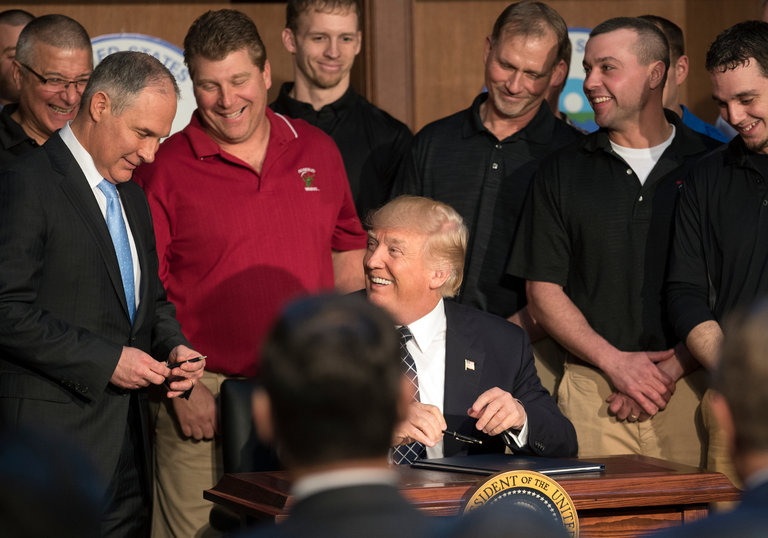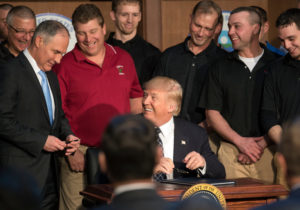
By Chuck Conconi
When President Trump, surrounded by representatives of the coal mining industry, signed his photo-op executive order cutting President Obama’s environmental regulations that had impacted the industry, he boasted: “My action today is the latest in a series to create American jobs … We will put our miners back to work.”

It was an empty prediction, but to coal mining families in depressed areas of such states as Ohio, Pennsylvania, West Virginia and Kentucky, Trump was fulfilling a promised he made during his campaign. It was why so many of them had voted for the billionaire who lived in a gilded tower in New York City. They believed he was going to bring back coal.
What Trump said ignores the reality of a dying industry. Competition from automation and other energy sources, especially natural gas, is having a devastating impact on coal production employment.
According to the Bureau of Labor Statistics, the United States presently produces nearly 50 percent more coal than it did in 1940. And it achieves that level of production with about 13 percent of the miners employed then.
I grew up in coal country in Ohio. Both of my grandfathers immigrated to the United States from Italy to work in the mines. Every male in my family including my father and my uncles were coal miners. Both grandfathers died young. My father, who was 11-years-old, when his father died, always believed he died from the deadly coal dust disease known as black lung.
Coal was king. In the autumn months, trucks would lumber down neighborhood streets to dump a winter supply of coal into the basements of virtually every home and there was a comforting odor to the coal smoke that blunted the impact of cold winter nights.
After the United Mine Workers Union battles of the 1930s and 1940s, a man could make a good wage working in the mines. He didn’t even need to have finished high school. My father and uncles left school after the eighth grade. They were able to afford to get married, own a home and buy a car.
It was a dangerous place to work, but there was a certain bravado about being miner, working in an environment that was dangerous: It was something like being a forest fire fighter or an Army paratrooper. I often sat and listened as they would get together in a Miners’ Union Hall drinking beer and telling stories about cave-ins and explosions they had survived.
My father and two of my uncles did leave the mines for factory work. One uncle had his chest crushed in one accident and later his back broken when a rock fell on him. He spent more than a year in a full-body cast and wanted to return to the mines when he recovered, but that was not possible.
My generation escaped the mines. By the time I was growing up, the deep mines had given way to strip mining – a fast and environmentally devastating way to extract the coal, leaving ugly cuts into the hills and dumping slag debris that polluted streams and a landscape where little or nothing would grow.
My experience was different from all those families in places like West Virginia and Kentucky. They believed the jobs would continue to be there even as automation and cheaper natural gas and environmental concerns made coal a less attractive energy source.
According to the Bureau of Labor Statistics, as of this February, there were only 50,300 working in the coal industry. A Washington Post article on the coal industry quoting figures from the Census Bureau’s County Business Patterns comparing the coal industry with other employments, points out that Arby’s restaurants employ nearly 80,000; J.C. Penney some 114,000, and Walmart, 2.2 million.
People working in those service industry jobs don’t make nearly the wages that can be earned mining coal, but they are not dying industries. In the areas where coal had thrived, entire communities now suffer. If coal mining families don’t have the money to spend, there is an impact on local restaurants, stores and auto dealerships.
Unfortunately, President Trump’s reducing of regulations will have minimal impact. Initially there may be a few more jobs added, but the reality is that King Coal is dying and the answers aren’t in eliminating mine safety or environmental pollution regulations. The answers are in finding new ways to attract other industry and in education and training for those depressed areas. Photo-ops are easy. Finding real answers, like fixing health care, are difficult.

Be the first to comment